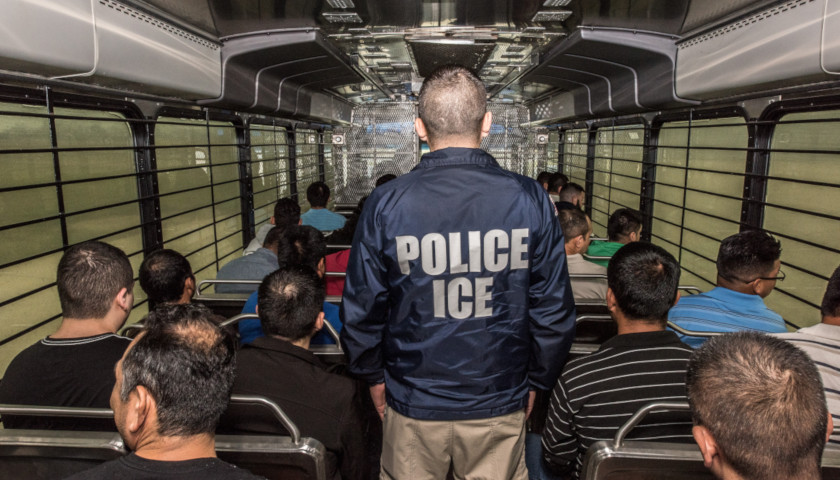by Jason Hopkins
More than 3,600 law enforcement agencies across the U.S. were handed detainers from Immigration and Customs Enforcement in the last fiscal year, indicating how necessary local and state cooperation is for federal immigration authorities.
ICE sent immigration detainers to a total of 3,671 different law enforcement agencies during the 2019 fiscal year, according to data the Transactional Records Access Clearinghouse (TRAC) at Syracuse University released Monday. The total is slightly down from the previous fiscal year, and a breakdown of the data reveals that a vast majority of these agencies receive fewer than two detainers requests a week.
 An ICE detainer is a request to temporarily hold an individual in order for a federal immigration officer to arrive and assume custody of that individual. In this case, these detainers are in reference to criminal illegal aliens who have landed in local or state custody for an unrelated crime and have caught the attention of ICE officers.
An ICE detainer is a request to temporarily hold an individual in order for a federal immigration officer to arrive and assume custody of that individual. In this case, these detainers are in reference to criminal illegal aliens who have landed in local or state custody for an unrelated crime and have caught the attention of ICE officers.
A county sheriff, for example, could arrest an illegal alien for a DUI. That individual’s arrest would then prompt ICE to lodge a detainer request with the sheriff’s office, asking it to hold the alien long enough for an officer to arrive and make an apprehension.
ICE lodged a total of 165,487 detainers in fiscal year 2019, according to data the agency provided. The information TRAC released reveals that detainers were spread to a total of 3,671 law enforcement agencies across 2,158 counties — encompassing every state in the country.
The data indicate how integral local and state cooperation is for federal immigration authorities, which count on these law enforcement agencies to transfer custody of many illegal aliens.
“It is imperative to recognize the role local and state law enforcement plays in immigration enforcement. It is local law enforcement that is most likely to come in contact with criminal aliens in their own communities,” Federation for American Immigration Reform (FAIR) spokesperson Matthew Tragesser told the Daily Caller News Foundation.
“Without full cooperation from these officials, there is the risk of a dangerous criminal illegal alien being released back into a local community and then committing additional crimes,” he continued.
Largely as a backlash to the Trump administration’s crackdown on illegal immigration, an increasing number of localities are, in fact, refusing to work with ICE.
Numerous “sanctuary cities” have been popping up across the country, passing laws and ordinances that forbid their agencies from honoring ICE detainers or assisting federal immigration authorities in most circumstances. Sanctuary laws have also been enacted across entire states.
The Orange County Jail in California, for example, was among the top 10 recipients of ICE detainers in fiscal year 2019. However, because of a statewide ban that prohibits cooperation with federal immigration authorities, the Orange County Sheriff’s Department has been forced to ignore these detainers and release thousands of illegal aliens since the law went into effect — 1,106 inmates in 2018 and another 1,015 in 2019.
Of the illegal aliens who were released in Orange County, in spite of ICE detainers placed on them, 411 of them were re-arrested. Many of those who were re-arrested were booked for rape, child sex offenses, assault with a deadly weapon, domestic violence, DUI and identify theft.
“When local and state authorities fail to comply with ICE detainers, they are jeopardizing public safety and undermining federal law. If local or state authorities ignore an ICE detainer, they force ICE officials to make arrests in public,” Tragesser told the DCNF, adding:
“This is dangerous for the ICE officials, local community members, and the family and friends of the illegal alien.”
“While it is alarming to see jurisdictions continue to ignore ICE detainers, the Department of Homeland Security has acted aggressively to combat this trend,” he added. “In recent weeks, the agency has filed federal lawsuits, sent U.S. Border Patrol personnel to interior sanctuary cities, and suspended Trusted Travel Programs in a sanctuary state.”
Many of these sanctuary jurisdictions say they shouldn’t be bothered with illegal immigration enforcement, arguing that it is solely a federal matter; however, a closer look at the data shows that these law enforcement agencies receive relatively few detainer requests over the year.
Of the 3,671 law enforcement agencies that received a detainer request in fiscal year 2019, 9% of them received more than 100 detainers throughout the year, or an average of two or more a week, according to the TRAC data. Additionally, eight law enforcement agencies received an average of five detainer requests or more a day.
– – –
Jason Hopkins is a reporter for the Daily Caller News Foundation.





